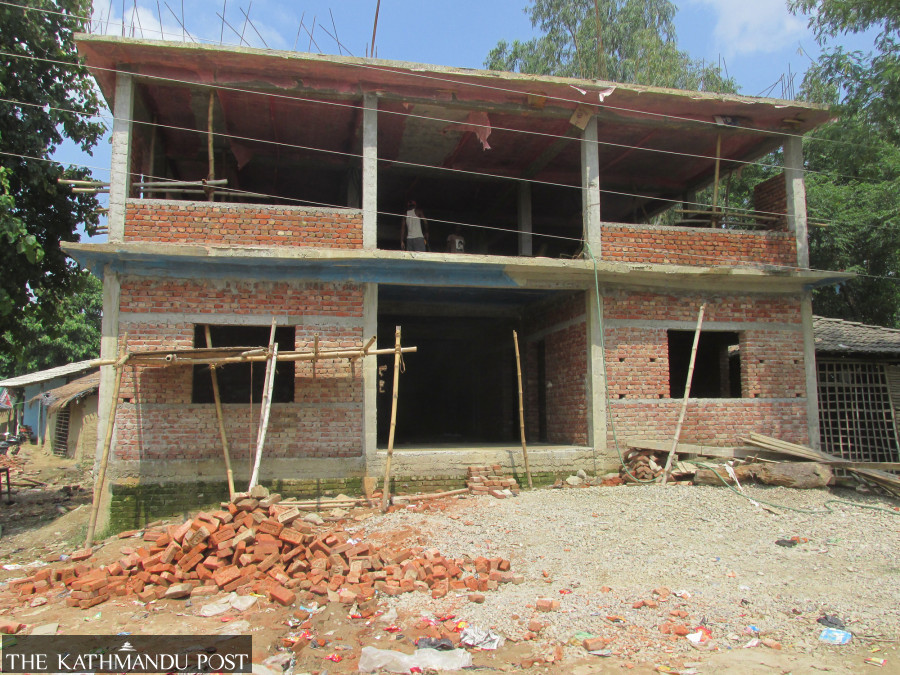National
Tenure of most elected local representatives to end without serving from own buildings
So far administrative buildings for 30 local governments have been completed with financial and technical help of the federal government.
Prithvi Man Shrestha
Prasauni Rural Municipality in Bara has been running its office at a small old building for the last two years as it does not have a new facility to deliver its services from.
“The building, like a hut, is narrow and cannot accommodate many service seekers,” said Dhanendra Bhujel, chief administrative officer at the local government. “We are renting some other buildings to provide the services.”
Now Parsauni is preparing to award a contract to build its own office complex within 18 months after the construction begins.
With just one year of the tenure of elected representatives at the local level remaining, incumbent people’s representatives in this rural municipality may not be able to provide services from the new building.
There are hundreds of local governments without their own administrative buildings. An assessment of the Ministry of Federal Affairs and General Administration showed 535 local governments out of the 753 need new administrative buildings.
But citing the demand for new buildings from 280 local governments, the federal government is allocating funds only to them under the resource sharing mechanism. Officials at the ministry, however, say they expect demand for resources from more local governments in the days to come.
So far administrative buildings in 30 local federal units have been completed with the financial and technical backing of the centre, according to the Department of Local Infrastructure under the Ministry of Federal Affairs Ministry, which coordinates Kathmandu’s support to the local governments.
“As most local governments have failed to get their own administrative building so far, the tenure of most elected representatives at the local level will end without entering new administrative buildings,” said Home Nath Poudel, information officer at the Department of Local Administration.
Department officials, however, say more buildings are in the final phase of completion and some 40 to 50 local governments are expected to get their new buildings by the end of this fiscal year.
“Some local governments have constructed buildings with their own resources but their number is small,” said Poudel.
Only 54 percent of the local governments had their own buildings to run administrative works, according to the Nepal Federal Capacity Needs Assessment Report published in August 2019.
However, officials say many of them do not meet the needs of local governments.
As per the Working Procedure on Local Level Administrative Building Infrastructure Development Programme endorsed by the Cabinet in December 2019, rural municipalities can get up to 60 percent of the total cost of constructing the administrative building. The municipality can receive up to 50 percent of the cost while sub-metropolitan cities get 40 percent of the cost.
“As the metropolitan cities didn’t demand resources from the centre, no cost sharing mechanism has been arranged for them,” said Poudel.
The federal government shares 60 percent of the cost if it doesn't exceed Rs90 million in the case of rural municipalities. It shares only 50 percent of the cost with a municipality if the total cost of constructing a building is maximum Rs120 million. “If the cost of constructing a building exceeds these limits, the department will not share the cost incurred beyond them,” said Poudel.
The poor progress in administrative building construction is evident also from the fact that the federal government spent only Rs1.6 billion in the past two years on sharing the cost.
According to the department, the total estimated cost of building structures for 280 local governments stands at Rs30 billion. The federal government is expected to share a half of that amount.
Despite the slow progress in construction, the federal government has been allocating funds much lower than what is required.
For the next fiscal year, the Finance Ministry has allocated a total of Rs800 million for the buildings. In the current fiscal year too, around Rs800 million was allocated but the government provided an additional Rs44.63 million recently to 45 local governments.
In the next fiscal year, the federal government wants to help at least 70 local governments to complete their buildings. “If extra resources are needed due to the inadequacy of current allocation, more resources can be provided later,” said Poudel, the information officer at the Local Administration Department.




 17.12°C Kathmandu
17.12°C Kathmandu














